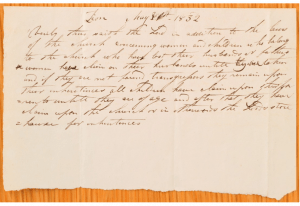Historical Context and Background of D&C 83

Video Overview
Brief Synopsis by Steven C. Harper
While he was in Missouri in spring 1832, Joseph “received a welcome known only by brethren and sisters united as one in the same faith.”1 These Saints, including widows Phebe Peck and Anna Rogers, were acting on the law of consecration as best they could. The law specified that “individuals” should consecrate surplus to the storehouse maintained by the bishop so that “every man who has need may be amply supplied and receive according to his wants,” but it was not clear that women could be supplied as well (D&C 42:33). Section 83 is an “addition to the laws” already given.2 It clarifies that the storehouse is for widows, orphans, and children whose parents cannot provide for them. “They have claim upon the church, or in other words upon the Lord’s storehouse, if their parents have not wherewith to give them inheritances” (D&C 83:5). The storehouse, in turn, is to be stocked by the consecrated offerings of the Latter-day Saints. “Widows and orphans shall be provided for, as also the poor” (v. 6).
Generally speaking, Latter-day Saints past and present have practiced these principles beautifully. When he dedicated the new Bishops’ Central Storehouse in 2012, then-President Dieter F. Uchtdorf recalled his boyhood in post-World War II Germany, when food, clothing, and bedding was sent from the Church’s storehouses to meet the needs of his family and others.3
1. “History, 1838–1856, volume A-1 [23 December 1805–30 August 1834],” p. 213, The Joseph Smith Papers, accessed July 7, 2020.
2. “Revelation, 30 April 1832 [D&C 83],” p. [1], The Joseph Smith Papers, accessed July 7, 2020.
3. Heather Whittle Wrigley, “President Uchtdorf Dedicates New Bishops’ Central Storehouse,” Church News (January 26, 2012).
Additional Context by Casey Paul Griffiths
From Doctrine and Covenants Minute
During his trip to Missouri in the spring of 1832, Joseph Smith received section 83 while in council with leaders of the Church in Missouri. The revelation deals with the laws of the Church, specifically the law of consecration and how it was administered to women and children who had lost their husbands or fathers. The question of how to administer the law of consecration may have been brought to the forefront of Joseph’s mind during a visit Joseph made to a settlement consisting primarily of Saints from Colesville, New York. These Saints had traveled to Missouri and settled at Kaw Township, about twelve miles away from Independence, Missouri. Some of these Saints were among Joseph’s closest friends and the earliest converts to the Church. Joseph later wrote that when he visited the Colesville Saints he “received a welcome only known by brethren and sisters united as one in the same faith, and by the same baptism, and supported by the same Lord.” He also added, “The Colesville Branch, in particular, rejoiced as the Ancient Saints did with Paul. It is good to rejoice with the people of God.”1
The Colesville Saints had been involved in some of the most dramatic and important events in the history of the young Church. They had heeded the call to gather to the Ohio, but the owner of the land that they were asked to settle on went back on his promise to live the law of consecration (D&C 54). They were commanded to relocate to Missouri and made the long journey there at great sacrifice, rejoicing with the Prophet when they arrived in the land of Zion (D&C 59). Among this dedicated company were at least two widows: Phebe Crosby Peck, who had four children; and Anna Slade Rogers, who had a daughter. Both women had lost their husbands in 1829 before the law of consecration was revealed. Joseph’s friendship with them may have led to him asking the Lord how the law of consecration related to the widows and fatherless.2
See “Historical Introduction,” Revelation, 30 April 1832 [D&C 83]
1. JS History, vol. A-1, p. 213, JSP.
2. William G. Hartley, Stand By My Servant Joseph, 2003, 112.
